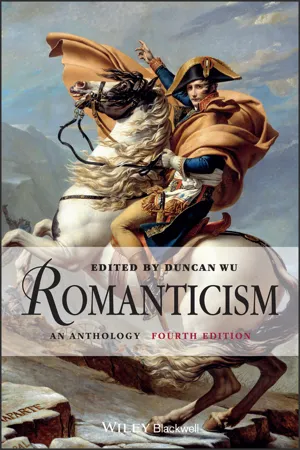
- English
- ePUB (mobile friendly)
- Available on iOS & Android
About this book
Praise for the third edition:
"An outstanding anthology, an excellent choice for advanced undergraduate courses on the Romantic era. This edition's improvements include illustrations, a detailed chronology, and expanded selections from women poets. I look forward to using this edition of Romanticism for years to come." Kim Wheatley, College of William and Mary
"This anthology, even more magnificent and indispensable in its Third Edition, is not simply the most useful or the most learned anthology of English Romantic poetry and thought; it is the most exciting." Leslie Brisman, Yale University
Duncan Wu's Romanticism: An Anthology has been appreciated by thousands of literature students and their teachers across the globe since its first appearance in 1994, and is the most widely used teaching text in the field in the UK. Now in its fourth edition, it stands as the essential work on Romanticism. It remains the only such book to contain complete poems and essays edited especially for this volume from manuscript and early printed sources by Wu, along with his explanatory annotations and author headnotes. This new edition carries all texts from the previous edition, adding Keats's Isabella and Shelley's Epipsychidion, as well as a new selection from the poems of Sir Walter Scott. All editorial materials, including annotations, author headnotes, and prefatory materials, are revised for this new edition.
Romanticism: An Anthology remains the only textbook of its kind to include complete and uncut texts of:
- Wordsworth and Coleridge, Lyrical Ballads (1798)
- Wordsworth, The Ruined Cottage, The Pedlar, The Two-Part Prelude, Michael, The Brothers and the Preface to Lyrical Ballads (1800)
- Charlotte Smith, Elegiac Sonnets (3rd edn, 1786), The Emigrants, Beachy Head
- Felicia Dorothea Hemans, Records of Woman sequence (all 19 poems)
- Byron, Childe Harold's Pilgrimage Canto III and Don Juan Dedication and Cantos I and II
- Blake, Songs of Innocence and of Experience, The Marriage of Heaven and Hell, and Urizen
- Shelley, Prometheus Unbound, Epipsychidion, The Mask of Anarchy and Adonais
- Keats, Odes, the two Hyperions, Lamia, Isabella and The Eve of St Agnes
- Hannah More, Sensibility and Slavery: A Poem
- Anna Laetitia Barbauld, Eighteen Hundred and Eleven
- Ann Yearsley, A Poem on the Inhumanity of the Slave-Trade
- Helen Maria Williams, A Farewell, for two years, to England
As well as generous selections from the works of Mary Robinson, John Thelwall, Dorothy Wordsworth, Robert Southey, Charles Lamb, Thomas De Quincey, William Hazlitt, Leigh Hunt, John Clare, Letitia Landon and Elizabeth Barrett Browning.
Visit www.romanticismanthology.com for resources to accompany the anthology, including a dynamic timeline which illustrates key historical and literary events during the Romantic period and features links to useful materials and visual media.
Frequently asked questions
- Essential is ideal for learners and professionals who enjoy exploring a wide range of subjects. Access the Essential Library with 800,000+ trusted titles and best-sellers across business, personal growth, and the humanities. Includes unlimited reading time and Standard Read Aloud voice.
- Complete: Perfect for advanced learners and researchers needing full, unrestricted access. Unlock 1.4M+ books across hundreds of subjects, including academic and specialized titles. The Complete Plan also includes advanced features like Premium Read Aloud and Research Assistant.
Please note we cannot support devices running on iOS 13 and Android 7 or earlier. Learn more about using the app.
Information
Table of contents
- Cover
- Series Page
- Title Page
- Copyright Page
- Dedication
- Illustrations
- Plates
- Abbreviations
- Introduction
- Editor’s Note on the Fourth Edition
- Editorial Principles
- Acknowledgements
- A Romantic Timeline 1770–1851
- Richard Price (1723–1791)
- Thomas Warton (1728–1790)
- Edmund Burke (1729/30–1797)
- William Cowper (1731–1800)
- Thomas Paine (1737–1809)
- Anna Seward (1742–1809)
- Anna Laetitia Barbauld (née Aikin) (1743–1825)
- Hannah More (1745–1833)
- Charlotte Smith (née Turner) (1749–1806)
- George Crabbe (1754–1832)
- William Godwin (1756–1836)
- Ann Yearsley (née Cromartie) (1756–1806)
- William Blake (1757–1827)
- Mary Robinson (née Darby) (1758–1800)
- Robert Burns (1759–1796)
- Mary Wollstonecraft (1759–1797)
- Helen Maria Williams (1761–1827)
- Joanna Baillie (1762–1851)
- William Lisle Bowles (1762–1851)
- John Thelwall (1764–1834)
- William Wordsworth and Samuel Taylor Coleridge, Lyrical Ballads (1798)
- William Wordsworth (1770–1850)
- Sir Walter Scott (1771–1832)
- Dorothy Wordsworth (1771–1855)
- Samuel Taylor Coleridge (1772–1834)
- Francis, Lord Jeffrey (1773–1850)
- Robert Southey (1774–1843)
- Charles Lamb (1775–1834)
- William Hazlitt (1778–1830)
- James Henry Leigh Hunt (1784–1859)
- Thomas De Quincey (1785–1859)
- Benjamin Robert Haydon (1786–1846)
- George Gordon Byron, 6th Baron Byron (I788–I824)
- Richard Woodhouse, Jr (1788–1834)
- Percy Bysshe Shelley(1792–1822)
- John Clare (1793–1864)
- Felicia Dorothea Hemans (née Browne) (1793–1835)
- John Gibson Lockhart (1794–1854)
- John Keats (1795–1821)
- Hartley Coleridge (1796–1849)
- Mary Wollstonecraft Shelley (née Godwin) (1797–1851)
- Letitia Elizabeth Landon (1802–1838)
- Elizabeth Barrett Browning (1806–1861)
- Plates
- Index of First Lines
- Index to Headnotes and Notes